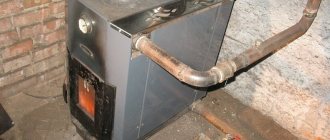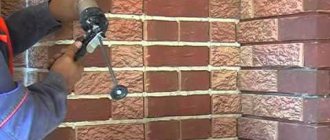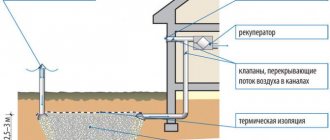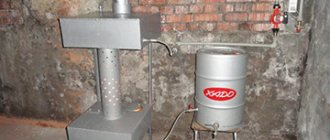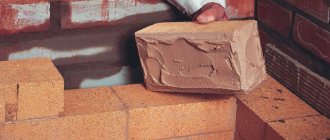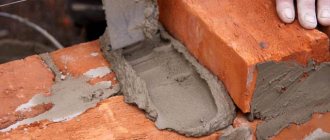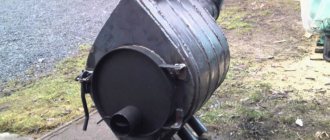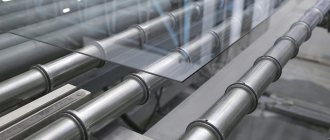Special putty is what you need to coat the oven with to prevent it from cracking
You can buy this mixture for eliminating cracks or make it yourself.
Fireproof putty for stoves and fireplaces purchased at a building materials store is ideal for repairs. It perfectly withstands temperatures of 1000 degrees. Before applying it, the stove and cracks should be treated with water. You can do the grouting yourself, following the instructions:
- Pour clay into a container and break up the lumps.
- Fill it with water and leave for 12 hours.
- Pour sand into the clay and knead the mixture.
- Finely chopped straw is added in small portions.
- Add one pack of salt.
Sand and clay are mixed in a ratio of 1:4. For 4 buckets of clay you will need about 50 kilograms of straw.
Production of material
It is important to store the dry fireclay clay mixture in a dry place
To make a solution of fireclay clay for laying out a stove with your own hands, you need to follow certain instructions and use the main components in certain proportions.
Fireclay powder has the properties that it acquired depending on the production method. The fraction of the material also matters. Fireclay clay has its own special marking. If the letter “U” is indicated on the packaging, this indicates the use of defective kaolin in production. It is cheaper, but you should not use it in important work. Options for diluting fireclay clay:
- 2 parts of fireclay sand with a fraction of no more than 0.5 mm to 1 part of kaolin;
- 4 parts fireclay sand to 1 part kaolin and the same amount of blue clay.
For the durability of the treated surface, the solution with clay must be mixed correctly
Ordinary sand should not be used when preparing such a solution. When heated, it will expand greatly. River water should also not be used, as it will not provide the necessary adhesion. If the solution needs to be more durable, Portland cement is added to it. But this ingredient will reduce the fire resistance characteristics. If you take into account all these features, working with this material will be easy and simple.
It is important to keep the solution and not rush to add water to it. Patience is key here, otherwise the clay will crack.
There are special compositions for quick mixing. They are convenient because you don’t have to wait for several days. True, they cost more. PVA glue is added to this mixture. Fiberglass is used for reinforcement.
Technical specifications
When purchasing fireclay clay, you need to pay attention to the shelf life of the material. It is also important that the seller stores it in suitable conditions. Deteriorate the properties of the material:
- wet air;
- long-term storage;
- water access.
The shelf life of the material is 3 years if it is stored in a dry place and the integrity of the original packaging has not been compromised. What parameters should high-quality clay have:
- inclusion sizes are around 2 mm;
- moisture absorption rates - from 2 to 10% for high-burnt, and up to 20% for low-burnt;
- humidity - no more than 5%;
- fireproof rating - up to 1850 degrees.
The main advantages of clay with refractory properties include its ability to withstand high temperatures. It also has good adhesion characteristics and vapor permeability. Other advantages include:
- long service life;
- environmental friendliness;
- reliability.
The downside is the high cost when compared with similar types of clays.
Advantages and disadvantages
This material does not cause controversy both among professional builders and among those who like to do household work with their own hands, since it is practically indispensable in the manufacture of stoves and various fireboxes. Fireclay clay does not have any obvious disadvantages, but this does not exclude its negative properties. The advantages of the material include:
- Excellent heat resistance;
- Reliability and long-term durability during professional masonry;
- Environmental friendliness of the material;
- The presence of micropores for the passage of steam, which also prevents the expansion of the masonry and its destruction;
- High level of adhesion.
There are fewer disadvantages, and besides, they are typical for many high-quality materials:
- High cost, since the production of such clay is technologically more complex and dangerous than the production of ordinary building clay;
- Fireclay dust enters the respiratory tract, so it is necessary to use a respirator when working.
Checking the properties of the main ingredient of the refractory mixture
There are several proven methods for checking the quality of clay:
Determining the readiness of the solution.
- Take about 1 kg of dry clay (0.5 l) and pour water into it portionwise, mixing it with your hands. The clay should completely absorb water and be a solution with a thick consistency. The next step is to roll balls with a diameter of 4-5 cm. A flat cake with a diameter of 9-10 cm is made from the resulting ball. All this is dried naturally for 3-4 days. Next, inspect for surface cracks. Identification of cracks on the ball and cake indicates increased fat content of the material. If no cracks are found on the ball and cake, then it is necessary to drop the ball from a height of no more than 1 m. The preservation of the integrity of the ball after the fall indicates the quality of the clay, and destruction shows that the clay is thin.
- Take approximately 3.6-5.4 kg of clay (2-3 l) and pour it into a container, thoroughly mixing with a wooden spatula and kneading the lumps. If the clay sticks to the shovel quite well, it means it has a high fat content. You need to add a little sand to this solution. If the clay remains partially on the blade, then such material is considered high quality and suitable for use. Poor adhesion of the mixture indicates that the mixture is lean and requires the addition of fatty clay.
- Take up to 1 kg of dry clay (about 0.5 l) and prepare a thick solution, mixing thoroughly with your hands. Balls with a diameter of 4-5 cm are prepared from the resulting composition. Next, take two smooth plates of chipboard or wood, place the ball on one of them, cover with the other and squeeze until cracks appear on the ball. Test control:
- if the ball collapses at the slightest pressure, it means the clay is thin;
- if cracks appear when squeezing up to 1/4-1/5 of the diameter of the ball, then the clay has a low fat content;
- if cracks appear when compressed to 0.3 of the ball diameter, then the mixture is normal and suitable for further use;
- Oily clay cracks when compressed to 0.5 times the diameter of the ball.
- A ball is made from the resulting steep solution and rolled out until sausages with a diameter of 1-1.5 cm and a length of 160-200 mm are formed. Next, they are stretched until they break. A sample made of lean clay practically does not stretch and gives a rather uneven break. Normal clay is characterized by smooth stretching and breaks when thinned to 20% of the original sample. Oily clay, on the contrary, stretches out gradually and gives a smooth break with the formation of sharp ends at the point of break.
Making your own mixture - all options
Having understood the principle of determining the plasticity of a masonry mortar, you can begin mixing it. This operation can be done with your own hands using different methods. A very simple technique that we, in fact, have already considered. You need to soak the clay in a small volume of water 24 hours before the planned procedure for laying the stove. Then (a day later) add liquid to the soaked material and mix the composition with a shovel until it becomes creamy. After this, you need to strain the resulting mixture and add sand to it (remember the proportions indicated above).
Mortar on brick
In cases where impeccably clean clay is used (without foreign inclusions and small stones), the mixture for stoves can be prepared with your own hands using the second method. Its essence is this. Add fine sifted sand to clean clay and fill the resulting composition with water (a quarter of the total volume of the mixture). Mix the mixture thoroughly until it reaches a creamy consistency. At the exit, it should slide off the shovel without difficulty, but under no circumstances should it spread. The next step is to add cement and salt to the resulting composition. These components will increase the strength characteristics of the clay mortar for the oven. For 10 liters of mixture take 750 mg of cement, about 200 g of salt.
The third method involves the use of fireclay and chamotte sand. These components should be mixed with each other in the same ratio. Then add water to the mixture. Its amount is 25% of the volume of clay. Mix the composition. That's all. This is perhaps the most basic way to prepare mortar for laying stoves. There is another method for preparing the mixture we are interested in with your own hands. It is made from loam. You will have to mix 10 small portions of different solutions. The first mixture has proportions - part cement + part sand + 10 parts loam, the second - 2 hours sand + 1 hour cement + 9 hours clay and so on. The latter composition will thus contain 1 hour of cement, 10 hours of sand and 1 hour of loam.
All mixed solutions should be placed in small boxes and left until completely dry in the fresh air (6-7 days). After a week, you begin to inspect the resulting mixtures. For masonry, choose the composition that contains the maximum amount of clay and completely eliminates the phenomenon of cracking. Believe me, it will be ideal - it will be able to withstand oven heating temperatures of up to 500–600 °C without deformation or crumbling. Choose your own option for preparing clay mortar!
Fireclay sand
Fireclay is called sintered clay completely devoid of moisture. Refractory sand is usually obtained by grinding fireclay bricks, that is, from scrap. Bulk material is considered more resistant to fire than ordinary sand. It is recommended to add it to the solution for laying the combustion chamber. In addition, it interacts well with the heat-resistant brick from which it was obtained, which allows you to create a particularly strong bond. You should not skimp on this component. It is required in small quantities, but provides the longest service life, which is especially important for the combustion chamber.
How to dilute and what to mix fireclay clay with - step-by-step diagram
Step 1: Infuse the powder in water
To prepare a mortar from fireclay clay for plaster, we need a pack of fireclay powder. Pour the powder into the container, gradually adding water until the powder is completely covered with water. Before diluting the final solution, the fireclay clay must sit for at least three days.
Step 2: Making the final batch
After we have waited the required time, we will stir the resulting mixture again, adding a little quartz sand and water if necessary. If the solution turns out to be liquid, you can sprinkle in more powder; if it is too thick, dilute with additional water. The consistency of the ready-to-use solution should resemble sour cream - with such a thickness it will not drain from the surface and will stick well to the wall.
Of course, you can also purchase a composition for instant mixing - it does not require steeping for three days, but it also costs more. In any case, PVA construction adhesive should be added to the resulting composition; it would not hurt to reinforce such a solution with crushed fiberglass. Plastering with this solution does not require any special skills - just prepare large and small spatulas in advance and apply the solution evenly to the surface.
Step 3: Prepare the surface
Based on the reduced plastic properties of fireclay, it is imperative that the surface you want to plaster be provided with a mesh, and to improve adhesion, it must be treated with a good primer. Since we are most often talking about plastering stoves and fireplaces, the primer should be heat-resistant and the mesh should be metal. In this case, you will compensate for the plasticity of fireclay and achieve the highest fire resistance of the plaster.
How long will it take to dry?
Any potter knows that before firing a pot is dried for 5-7 days at a temperature of 18-50°. Despite the fact that the thickness of the pot is rarely more than 1 cm.
The width of the brick is 12 cm. Sometimes the masonry is 14, 18, 26 cm or more thick. Therefore, before full operation of the oven, you need to dry it in gentle conditions.
I advise clients to start burning it in small batches of firewood a day after the fireplace is built. Literally 4-5 poles. This needs to be done 2 times a day. In summer for 8-10 days, in autumn-winter for 3-4 weeks.
The method of Siberian masters
At the beginning of my stove-making career, I learned an old way of checking whether the stove was completely dry. We will need a bucket of water.
Place a bucket of water near the freshly built stove. There should be a constant draft in the room. All views, doors, flaps and rings must be open. The room temperature should be at least 18-20 degrees.
As soon as the water in the bucket evaporates, we can assume that the stove is dry. The moisture left the masonry, which means the clay locks opened.
Finally
Of course, it’s much easier to go and buy an iron stove. And it will be inexpensive, and will warm the room. But the difference in the quality of heat between a brick stove and a metal one will be as great as it is more difficult to build a brick one than to buy a ready-made one.
price/practicality rating
Fireclay clay is clay fired in a special oven at a temperature of 1500 degrees. The consequence of this procedure is an improvement in the heat-resistant characteristics of the material, as well as increased strength, comparable only to the strength of stone. The crushed material subjected to heat treatment is fireclay clay. The process of producing fireclay clay, as well as all the nuances associated with production and operation, can be learned by watching videos and photos on the Internet, which are in the public domain.
Fireclay clay is a durable and inexpensive material, characterized by increased waterproof and fireproof characteristics.
The composition of fireclay is extremely simple - it is white kaolin clay, fired and crushed. A ready-to-use mixture is obtained by adding water to crushed clay. For use in the construction of stoves and fireplaces, crushed clay diluted with water should be infused for three days. To ensure a uniform consistency, the mixture must be stirred for a very long time and thoroughly.
How long fireclay clay takes to dry depends on the room in which the work was carried out. So, in a dry room without drafts, fireclay will dry for about 10 days.
The ever-growing popularity of fireclay can be attributed to its natural chemical composition and high fire-resistant properties, as well as the fact that it does not shrink - therefore, does not crack when dry.
What is included in the process of preparing the solution?
The process of preparing the solution occurs according to the following algorithm:
- Dry clay is poured into a pre-prepared trough.
- If the clay can be classified as a fatty type, add river sand at the rate of 1 part clay to 2 parts sand.
- Then add water at the rate of 1 part water to 4 parts clay solution.
Determination of the plasticity of clay mortar.
The masonry mortar is ready. You can check it in a simple way: by making a round ball of small volume from the solution and throwing it with force on a hard surface. The ball will collapse if there is excess sand, if not, the solution is normal. You can also determine the quality of the clay before preparing the mixture. Taking half a liter of clay, mix it, gradually adding water, mix by hand until the clay solution sticks to your hands. At the end of the manipulations, roll a ball with a diameter of 40-50 mm, place it and let it dry for three days.
If there are cracks, it is necessary to add river sand to the mixture, after sifting it on a special sieve. If the ball is not damaged and does not collapse when dropped from a height of 1 meter, then the clay composition is suitable for construction.
The following method of testing clay is one of the most optimal. You need to beat 0.5 liters of clay by hand, like dough. From the specified mixture, prepare a spherical object with a diameter of 50 mm and, placing it between two parallel wooden planks and applying mechanical force, deform the ball until it cracks. Let's look at the result:
- the presence of skinny clay - the ball disintegrated;
- average presence of fatty parts in clay - deformation of 1/5 of the ball;
- normal clay - cracks when compressing 13 balls;
- greasy - the appearance of small cracks when deformed by half.
How to dilute clay to putty a stove
Despite the sea of modern technologies for laying stoves, fireplaces, fireplace complexes and all kinds of heating and decorative innovations, stoves are still laid using clay mortar. They also use it to repair, plaster, and correct defects in masonry. Ready-made clay stove mixtures have appeared in building materials stores. Unfortunately, it is only suitable for working with fireclay bricks, where ordinary clay will not work. In other cases, to prepare a masonry or coating mixture, you will have to look for clay yourself.
How to make a clay mixture
It is necessary to distinguish between the process of plastering a stove for whitewashing and the process of sealing cracks in masonry joints. Accordingly, the solution will require different thicknesses and compositions. The ideal clay for coating and repair is the same clay from which bricks are made. Unfortunately, they stopped making bricks on their own long ago, preferring to buy them, and therefore it’s impossible to find a “deposit” for them.
You should choose low-fat red clay, and if necessary, additionally deplete it with sand. The mixture for sealing cracks in seams is prepared as follows:
- We take a clay-sand mixture and experimentally determine the required proportions of the components. To do this, prepare a plasticine-like solution and roll small balls from it (no more than 2 mm in diameter).
- We stretch our hand with the clay ball forward and drop it on the floor. If the ball does not crack or smear with a blot, then this is an ideal mixture for repairing stove seams.
- Add finely chopped straw for reinforcement and 1 kg of salt per bucket of the mixture. You can start working.
The solution for plastering the stove is prepared in a similar way, only its consistency is creamy.
How to coat a stove
When starting repairs, you should warm up the stove a little before work. The procedure for sealing cracks in the furnace is as follows:
- remove all the crumbling layer and all the lime whitewash (clay will not fall on it);
- spray or wet the repair areas with a brush so that the dry areas bond better with the repair solution and do not draw moisture from it;
- seal the seams tightly with a plasticine-like mixture, and plaster the surface with a liquid solution.
You can coat the oven by hand or use a spatula and trowel.
After the solution has dried, additionally coat small cracks. Date: September 25, 2022
Instructions for use
The approximate consumption of fireclay clay during masonry is 25 bricks per 20 kg of dry mixture or 100 kg of mortar per 1 m 3 of masonry. You can prepare the solution yourself using a relatively small list of materials and tools. It is very important to perform all actions consistently, since otherwise the composition will be of poor quality, which will lead to rapid destruction of the masonry, which is especially dangerous in conditions of open fire.
How to dilute fireclay clay for laying a stove
It is impossible to use only fireclay sand for the composition due to poor ductility. It must be diluted with another suitable material: for example, ordinary clay or purified kaolin. In the first case, the ratio of products should be 2:1 (the first number is fireclay sand), and in the second - 4:1. There is no particular difference, other than the consumption of materials, between the options for adding either ordinary clay or kaolin.
It is very important to understand that ordinary sand cannot be used to prepare fireclay composition, since it expands when exposed to heat and exposes the masonry to gradual destruction. In addition, sand does not combine well with the components of the composition, which significantly reduces the service life of the masonry and reduces its reliability. Portland cement can be found as a special additive in fireclay mixtures. If the temperature in the furnace firebox does not reach high temperatures - above 700-800 C o, then its use is advisable, since Portland cement increases the strength of the mixture, but reduces the fire-resistant properties. In addition, a small amount of fiberglass chips can be added to the composition to give it strength.
The approximate procedure for preparing a mixture using kaolin is as follows:
- From the above ratio, the required amount of kaolin sand is derived. It is sold in exactly the same bags as fireclay sand, only it is not brown, but white. It is kaolin sand that will serve as the basis for the mixture along with fireclay.
- Fireclay sand is mixed in the same container with kaolin sand and gradually diluted with water. At this time, it is important to stir the mixture to distribute the water molecules between the molecules of the substance. At this stage, the mixture is prepared according to the approximate ratio. Water should be added in small portions so as not to spoil the composition. When the required amount of water has been added, the mixture must be left for three days so that it can absorb all the moisture and acquire the desired consistency, which should be similar to the consistency of sour cream.
- After the period has passed, you need to check the quality of the resulting composition and its thickness. If it is too liquid, then a mixture of kaolin and fireclay sand is added to it in the same ratio - 2:1, but if it is too thick, then water is added in small portions.
- The surface on which work is planned must be treated. For this, a special plastic construction mesh and a small spatula with fire-resistant putty are used. The surface to be treated is covered last: a layer (or several layers) of mesh is placed on top, after which another layer of fire-resistant putty is applied to the surface. When the surface preparation work is completed, you need to wait for the putty to dry.
In the store, fireclay clay can be bought in a twenty-kilogram bag, which is enough to lay up to 30 bricks
It is important to note that the layer of composition should not be very large, since in this case the heat will be slowly removed and accumulate in the walls of the firebox. This will lead to the fact that the side that is closer to the flame will be heated much more than the one further away, which will cause a difference in the speed of movement of molecules in the substance, and it will become covered with cracks. The larger the layer of compound between the bricks, the higher the likelihood of a sad outcome, so you need to ensure that there is no more than 2-3 cm of fastening compound between the bricks. In this case, this will not only reduce the consumption of the mixture, but also extend the service life of the masonry.
How to prepare a solution for plaster
From fireclay, you can make not only compositions for fire-resistant masonry, but also plaster for the design and repair of walls or as an intermediate fastening link between the wall and the facing material. In addition, fireclay plaster is used to give additional reliability to the stove masonry - it is used to treat the working surface to improve the adhesion of the low-plastic mixture to the surface. Fireclay putty is also used to cover the back walls of stoves, which, as a rule, open into other rooms, to create a barrier for heat and reduce heating of surfaces.
Chamotte mortar is recommended to be used in cases where it is necessary to obtain a perfectly flat surface
To prepare plaster, you need the same ingredients: fireclay sand, quarry sand and Portland cement. The components must be mixed in a ratio of 7:2:1, where 7 parts quarry stove, 2 fireclay and 1 Portland cement. To improve the quality of the plaster composition, you can add salt - approximately 100 g per 8 liters of putty.
The mixture must be kneaded carefully, paying special attention to how much water was added to the composition. If it has become too pale and has a consistency similar to pancake dough, then this is a poor-quality material that can only be corrected by adding the mixture described above in the same percentage. Good fireclay plaster has the consistency of not very thick sour cream. It should be approximately the same as the fireclay mixture for masonry, but at the same time more plastic and pliable than the latter.
Working with plaster follows a standard principle: several spatulas of different sizes and lengths are used, as well as serpyanka (a special mesh tape that is used to give strength to the seams and better connect the putty to the surface). The layer of putty cannot be made thick, since heat will be dissipated more slowly, which will negatively affect the reliability of the entire masonry.

